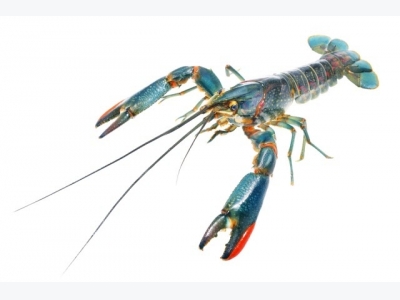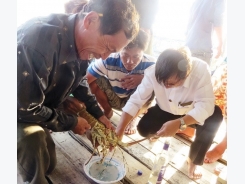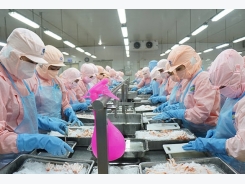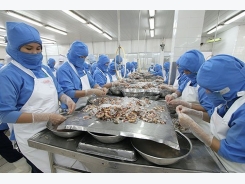Australian Red Claw Crayfish (Cherax quadricarinatus)

The Red Claw crayfish is a new and very promising aquaculture species. The Red Claw is very similar to the native American species, except that it grows to a HUGE size, almost to that of a lobster! This is a species with considerable potential for commercial culture. The features that made it suitable for aquaculture and the aquarium are its ability to withstand low oxygen levels and warm water associated with the tropics.
Australian RedClaw, Cherax quadricarinatus, is a tropical freshwater crayfish native to Australia. They are often called “freshwater lobsters” for their physical resemblance and large size. They are valued as both a food source and as an ornamental species. The Redclaw crayfish is the more common species of yabby in the Northern Territory, found in most lakes and rivers in North Australia. It thrives in any tropical freshwater environment. In nature, Cherax quadricarinatus are often found under roots or rocks, where they hide from predators and other species members. With an appearance similar to that of a lobster, the redclaw crayfish is a tropical Australian animal. It is a delicacy with the texture and flavor of the flesh comparing very favorably with other commonly eaten marine crustaceans. Fresh red claw have a smooth lustrous shell, deep blue to green in color, with males exhibiting a bright red coloring on the margins of their large claws. Cooked, they present as bright red, typical of premium crustaceans. The meat is arguably more healthy than traditional seafood products as it is low in fat, cholesterol and salt. It is one of the largest freshwater crayfish in the world. Average market sizes of 50 to 150 grams (1 pound = 454 grams) are achievable in 6-12 months, although they can reach up to 600 grams each.
Red Claw Coloration
Generally Australian Red Claw crayfish are blue to a blue/brown/green color. Because of their selective breeding in the hobby, they will not change to their original coloration, except in times of stress or when feed or housed incorrectly. The blue color seems to intensify when the water is clean, and be more green/brown when left in brackish water. The Blue Lobsters color intensifies as the crayfish matures.

Red Claw Diet
Red claw lobsters are scavengers. They are a bottom dweller and will eat anything they come across, as they are opportunistic eaters. They will eat all of the left over food your fish miss, as well as detritus and other waste off the bottom of your aquarium. Although this lobster will eat dead or dying fish as well, it is normally too slow to catch healthy fish. You want to offer both vegetables and animal proteins. The primary diet should include plant matter, worms, brine shrimp, bloodworms, or insect larvae, and can include vegetable matter waste from aquaponic systems such as lettuce, shredded carrots, zucchini, etc.. Adding a high protein fish or shrimp sinking pellet, flake food, and dried algae is also recommended.

Red Claw Reproduction
The key points to successful maintenance and reproduction of brood stock in indoor holding systems include:
- select healthy mature adults
- maintain warm temperatures (preferably 75 F to 85 F)
- maintain good water quality
- provide proper nutrition, and
- isolate berried females to hatching tanks
In a hatchery red claw can spawn almost continuously throughout the year if conditions are suitable. Red claw generally reach sexual maturity by the age of 6 to 12 months. Mature male red claw develop a distinctive red or orange patch on the outside margin of the claws. Individuals of this same size without the reddish claw patch are usually females. The sexes are best identified, however, by examination of the genital openings on the underside of the cephalothorax at the base of the walking legs. Females have a pair of genital pores at the base of the third pair (counting from the head) of walking legs. Males have a pair of small genital papillae (small projections) at the base of the fifth pair of walking legs.
Individual females do not spawn when going through a growth phase (i.e.,molting). Each female will produce 100 to 1,000 eggs per spawn depending on her size and general health. The first spawn of young females usually has fewer eggs than latter spawns. Newly spawned eggs average 10 eggs per gram of female. About 30 percent of the eggs are lost during incubation, resulting in an average of 7 eggs (that hatch) per gram of female. For example, a female weighing 3 ounces (85 grams) would produce about 600 eggs. This can be used to estimate the number of eggs a female of a given size will produce.
Broodstock And Hatchery
Mature broodstock Red Claw crayfish can be kept at a density of 1 to 2 per square foot of tank bottom. The ratio of females to males in each tank should be between 1 to 4 females for each male. Good spawning success has occurred using tanks with water depths of 1 to 3 feet. Small rectangular tanks of 15 to 20 square feet have been used successfully, as well as large circular tanks of 15 feet in diameter with 1-3 feet of water. Example: a 20 sq. ft. tank 2 ft deep could be stocked with 5-10 males and 15-30 female mature Red Claw. Broodstock tanks should maintain a water temperature between 75 and 85 F for optimal reproduction.
Breeding tanks should be checked every one to two weeks for berried females (females carrying eggs). Once the fertilized eggs are affixed to the female's pleopods, "swimmeretts" situated on the underside of the tail, It is highly recommended that berried females be moved to a separate tank. Berried females should be carefully netted, keeping them with their abdomen curled around the eggs during transfer to hatching tanks. (to prevent egg loss). Incubation takes approximately six weeks and the newly hatched juveniles rapidly become independent. The hatching tank will then become the nursery tank for raising the young Red Claw.
"Homes" are essential, RedClaw have a low level of aggression, but do require housing. PVC pipe sections in multiple sizes, mesh bags, burlap, rocks, or anything that the crayfish can climb threw and hide in for shelter. Young crayfish will molt many times during their first year of life, as they grow quickly, while mature redclaw crawfish will molt only once or twice a year. The shed exoskeleton ( molted shell ) is used as a source of calcium and is typically eaten by its owner or other crayfish. Red Claw in tanks can handle a temperature range from 60-90 F. Temperatures below 55 and above 95 will result in casualties.
Australian Red Claw As Pet
Red Claw crayfish are easy and fun to raise in your tropical aquarium as unique pets. The redclaw is a valued aquarium species with their exotic coloration. They are less aggressive than most crayfish, and reproduce rapidly and easily. One red claw lobster can inhabit a 25-gallon aquarium, and a 40-gallon aquarium with plenty of caves and space to move around can inhabit 2. The larger Australian red claw crayfish requires a tank that is at least 40 inches long and 20 inches deep.
The ideal tank environment consist of about 5 inches of aquarium sand or gravel on the bottom with pipes, tunnels, decorative rocks and caves. You can plant hardy plants in the aquarium, but small, weaker plants won't survive. You will want to make sure the aquarium has a filter to keep the aquarium clean combined with periodic partial water changes. Use test strips to monitor the pH levels which should be between 6.5 to 8. When cleaning the tank, test pH before and after changing the water to ensure levels remain within proper range. Use an aquarium heater and thermometer to measure the water temperature and maintain the aquarium between 77 and 90 degrees Fahrenheit. Temperatures below 55 or above 95 will result in casualties. Test the hardness, as well; they need hard water to thrive. You can add limestone to make the water harder, if necessary.
Plenty of cover should be included in the aquarium, including both rocks and plants (Although the plants will not last long as the crayfish gets larger). After molting the crayfish is vulnerable to attack and consumption by others. If the exuvia (shed exoskeleton, molted shell) is removed from the tank after shedding, the crayfish will likely die as this shed will be consumed for vital calcium. However If your water has enough calcium in it this will not be an issue.
RedClaw crawfish are excellent escape artists. Red claw are excellent climbers and escape from tanks if the water level is near the tank top, if rocks and decor are large enough for them to reach the surface or if equipment such as air line tubing or heater cords extends over the sides of the tank. To reduce escapes, equipment should be suspended from overhead so that it does not touch the sides of the tank and keep a lid on the aquarium.
Có thể bạn quan tâm
Phần mềm

Phối trộn thức ăn chăn nuôi

Pha dung dịch thủy canh

Định mức cho tôm ăn

Phối trộn phân bón NPK

Xác định tỷ lệ tôm sống

Chuyển đổi đơn vị phân bón

Xác định công suất sục khí

Chuyển đổi đơn vị tôm

Tính diện tích nhà kính

Tính thể tích ao hồ




 Redclaw crayfish (Cherax quadricarinatus)
Redclaw crayfish (Cherax quadricarinatus)  Shrimp exports to U.S. seen rebounding in late…
Shrimp exports to U.S. seen rebounding in late…